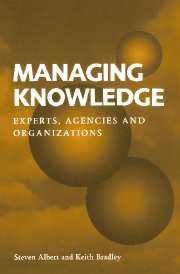Book contents
- Frontmatter
- Contents
- List of figures
- List of tables
- Introduction: the supply-side in context
- Part 1 Expert employees and their new organization
- 1 Trends in the labour market
- 2 Adaptations in the labour market and the expert employee
- 3 From the firm to the agency
- 4 Expert agency employment as a facilitator of intellectual capital
- 5 The temporal advantages of agency work for the expert employee
- 6 Taking stock
- Part 2 The labour market and the expert employee
- Appendix A Formal exposition of Winston model
- Appendix B Agency employment and search costs
- Notes
- References
- Index
2 - Adaptations in the labour market and the expert employee
Published online by Cambridge University Press: 23 November 2009
- Frontmatter
- Contents
- List of figures
- List of tables
- Introduction: the supply-side in context
- Part 1 Expert employees and their new organization
- 1 Trends in the labour market
- 2 Adaptations in the labour market and the expert employee
- 3 From the firm to the agency
- 4 Expert agency employment as a facilitator of intellectual capital
- 5 The temporal advantages of agency work for the expert employee
- 6 Taking stock
- Part 2 The labour market and the expert employee
- Appendix A Formal exposition of Winston model
- Appendix B Agency employment and search costs
- Notes
- References
- Index
Summary
A striking example of adaptive color change occurred among British peppered moths in the vicinity of Manchester. In the eighteenth century, all such moths collected were pallid in color; in 1849 a single black moth was caught in the vicinity, and by the 1880s the black moths were in the majority. Why? Because industrial pollution had blackened tree trunks in the vicinity, robbing the original moths of their camouflage while bestowing its benefits upon the few black moths there. Once pollution-control ordinances came into effect, the soot slowly washed from the tree trunks and the pale peppered moth population rebounded.
Timothy Ferris, Coming of Age in the Milky Way
Historians did not generally accept the notion of an ‘Industrial Revolution’ until 1881 when Arnold Toynbee used the term in a series of lectures to describe a major transformation of society, see e.g. Beniger (1989) and Toynbee (1884). Since that time other labelled transformations have been introduced and made popular. For example, in the early 1950s Boudling introduced ‘Organizational Revolution’ (Boudling (1953)); in 1971 Helvey first issued the ‘Age of Information’; more recently Piore and Sable (1984) popularized the term, ‘The Second Industrial Divide’ and in an increasingly more prescriptive literature Hayes et al (1988), Senge (1990), and Argyris (1993) made popular the ‘learning organization’. The works are similar; each frame a discussion on a particular aspect of organizations and labour markets at a particular time, and each tries to understand the associated phenomena by understanding the transformation process.
Similar to the foregoing scholars, our work is concerned with the transformation of organizations. Important to this discussion is the nature of transformation.
- Type
- Chapter
- Information
- Managing KnowledgeExperts, Agencies and Organisations, pp. 36 - 48Publisher: Cambridge University PressPrint publication year: 1997



